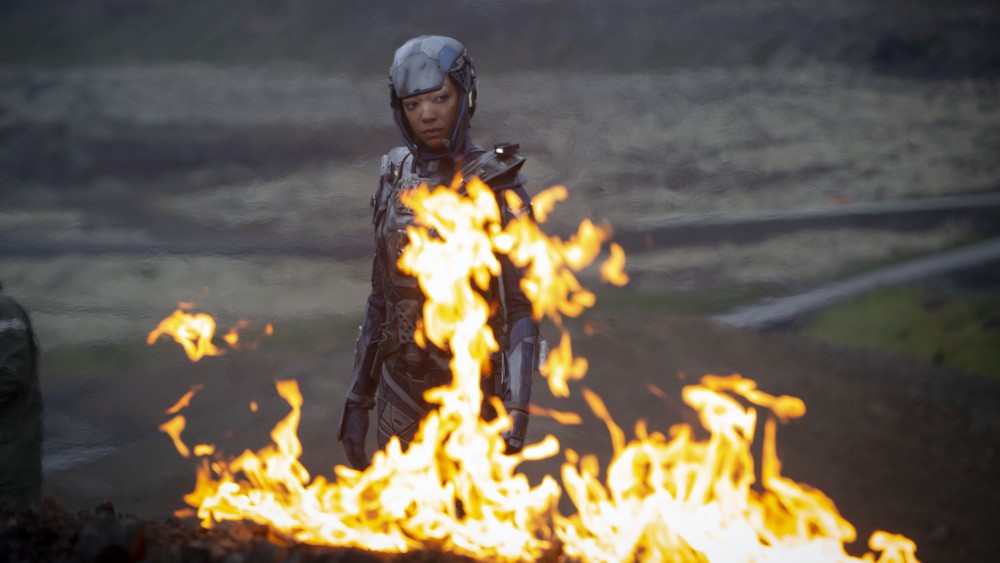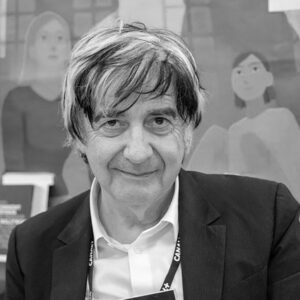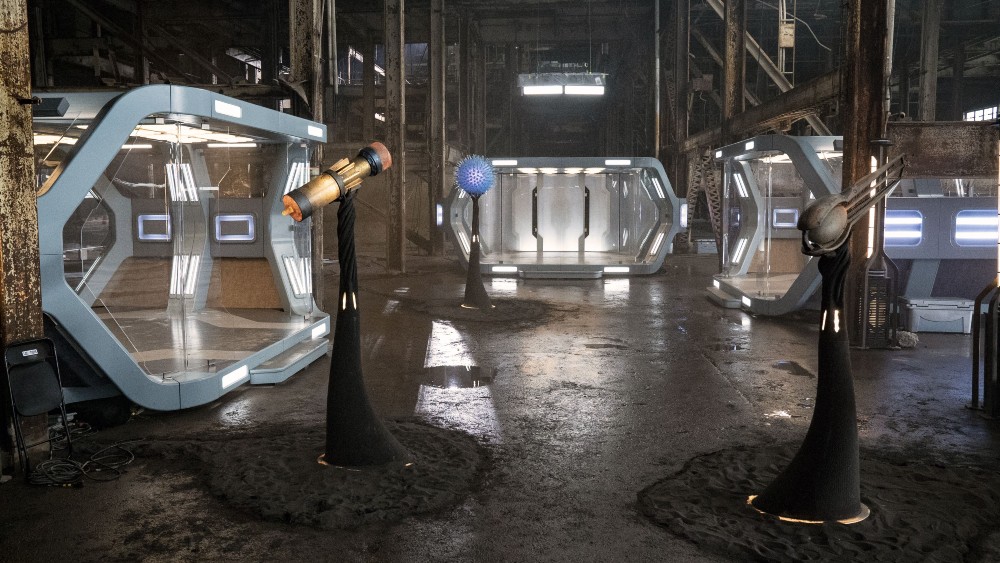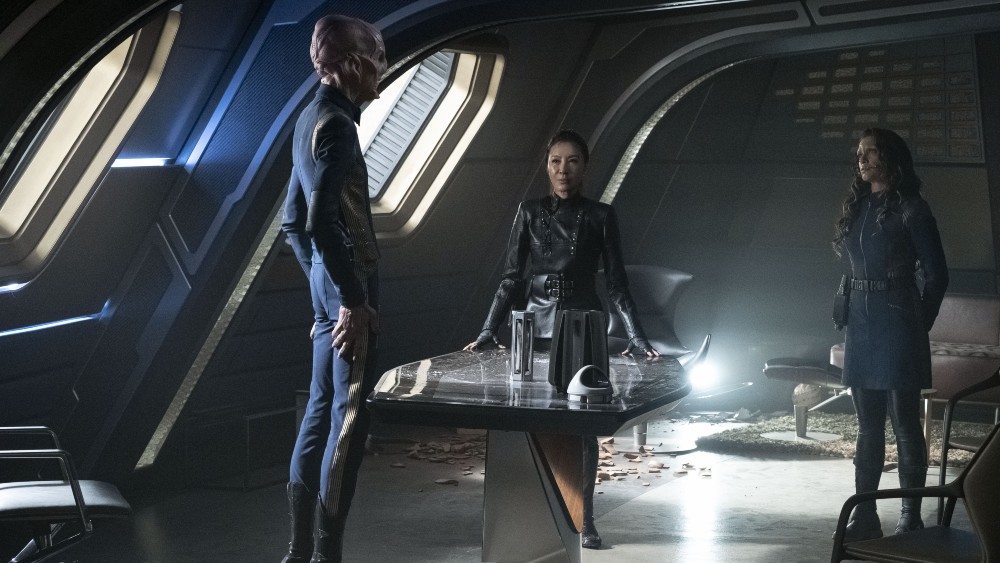
The third season of Star Trek: Discovery finds the crew of the starship Discovery in completely different worlds and times than the previous two seasons. On the edge of disaster at the end of season two, Michael Burnham (Sonequa Martin-Green) drops into a wormhole that propels her hundreds of years into the future, where she must find a way to reconnect with the rest of the crew.
A CBS Television Studios production, the Emmy-winning Star Trek: Discovery helped lead to a record number of subscriptions when it premiered on CBS All Access (now Paramount+).
Over a forty-year career, Production Designer Phillip Barker has worked in features, television series, and theater. He collaborated with Atom Egoyan on ten films (including The Sweet Hereafter) and two operas. He’s also worked with Brian De Palma, Mira Nair, Lisa Cholodenko, and other directors.
Barker’s short films have won awards around the world, and were the subject of the book Strange Machines, The Films of Phillip Barker by Mike Hoolboom. He received a Directors Guild of Canada Award for Outstanding Achievement in Production Design for Egoyan’s Where the Truth Lies.
Barker spoke with Below the Line from Nova Scotia. [Editor’s Note: There are a few spoilers for the third season in this interview.]

Below the Line: When did you join the Star Trek: Discovery crew?
Phillip Barker: I was suggested to Alex Kurtzmann, the executive producer, who had seen my experimental films, which often involve sets that move and appear to defy gravity. I had never done science fiction of this nature before, but I think it was my work that Alex responded to because obviously I didn’t have any science fiction sets to show him.
Below the Line: How well did you know the previous series and movies?
Barker: I may have been a good fit, because the storyline in Season Three is after the wormhole projected them into the future. It was a new game, starting fresh. It didn’t have to fit into any time period that existed in the other shows. We did nod to Star Trek history by redesigning classic ships from Voyager, that sort of thing. I did study Season One — I knew the Production Designer Tamara Deverell very well. She’s a friend and helped me get along.
Below the Line: Were the scripts completed?
Barker: We had a rough outline for all of them. For example, Book’s character [Cleveland Booker, played by David Ajala] was written, but in terms of design not really fleshed out at all. What type of ship he had, how it functioned, was left up to me and my department.
I had some prep time, so I interviewed scientists and artists and people who think about the future, about how it would look. Some things already exist, like natural ways of growing fabrics, belts made from mycelium leather. Or bionics for people with disabilities.
To me, the most interesting thing is the idea of nanobots, tiny robots that could be programmed to become anything. They are working on this now on a microscopic level. For instance, you could mash them together and program them to become clothing or furniture.
How would you interact in the future with your computer? Will it be an artificial intelligence that would be able to become very familiar with you as a person, know what you want, so you wouldn’t have to ask for it?
I talked about this to Alex, that the people on board go into their personal quarters, the computer scans their brains. If they wanted to lay down, the beds come out of the floor just as they’re laying down. Alex coined the phrase “programmable matter,” and you see it in Book’s ship’s controls.
How do you fly a ship in the future? Do you just think about which direction you want to fly? That wouldn’t be visually interesting, we had to come up with a filmic system. We had the idea of making Book’s controls programmable matter. You hover your hands over the control table. You can pull small pieces of matter up or push them down, you can pull them right out of the table and create a 3D model of, say, a planet. It wouldn’t be a hologram or a projection, it would be a physical object you could hold in your hand.
Book’s entire ship is made out of programmable matter, so it’s always taking a different shape. Say he’s being pursued across a ravine, he changes the shape of the ship to fit through. Parts of the ship can be detachable. The idea of programmable matter opened up a Pandora’s box for us where everything was not real, everything was a simulation of something else.
Below the Line: Did you have time to work with the other departments?
Barker: The way the series is set up, I joined a team of art department, illustrators, post-production CGI supervisors, people who were already working together. When I sketched the Federation headquarters, which is like a tall, vertical, tubular thing with ship quarters on top, also programmable matter so the shape of the floors changes, I would give my sketches to Ryan Dening, the concept artist, who would turn them into beautiful illustrations.
We’d send them off to Alex and the writers for approval, then we would decide what part of the sets we needed to build physically, keeping in mind which components were to be visual effects extensions.
When we got to the point where we were designing the physical ship we would be building, we would have weekly meetings around the art table. Everybody could come, camera, grips, electric, costume directors, and we would have roundtable discussions: this is what we want, how do we build it? Where do you want the lights? It involved everyone from stunts to special effects. It was one of my favorite times because the different departments on a show never really get together. This way it became a really collaborative set.
Below the Line: Some of Season Three was shot in Iceland, with some remarkable locations.
Barker: Part of it was being inspired by what we saw. There was a sequence already written where the ship is being eaten by parasitic ice, and we traveled down the glaciers and found where to shoot it.
It was a matter of choosing what’s there and then adapting parts of the story to them. Like the black volcano where Burnham crash lands, we knew we would use that, and places like the blue lagoon spa thermal waters, the mossy fields they walk across, the cave. That trip also informed the mining town because I saw this very flat, black sand beach next to a mountain. We then designed the big floating mining structures that you see in that sequence.
Below the Line: Did you keep a count of how many planets you had to design?
Barker: There’s a bunch. I love playing with antigravity, so I liked the inverted planet. And there was a hollow planet — it was a space that did not have gravity, just giant floating rocks. The planet where Su’Kal’s [played by Bill Irwin] parents crash-land. That changed many times during concept planning. The set design was super-interesting because Su’Kal is being kept alive in a programmable matter environment his parents made to protect him from radiation poisoning.
A lot of them have to blow up, you know, during the Big Burn.
I enjoyed playing with the time portal Georgiou [Michelle Yeoh] goes through. It already existed in the original series as a big rock with a hole in it that Sirk and Spock discover. We took the old design and made it bigger and shot it in a quarry in Ontario.
Another interesting set was the mining colony. We shot it at Stelco, a foundry in Hamilton, about an hour from Toronto. I don’t know how we convinced them, but we were the first film crew there in twenty years. The stuff you see on the ground, that’s existing. We augmented the shots with chunks of old rotten spaceships and piles of coke, but it was all based on stuff that was there. The whole introduction, where you looking down at the plant from the ship, that’s mostly drone footage of the real plant. It looks just like that.
All three seasons of Star Trek: Discovery are available to stream on Paramount+.







